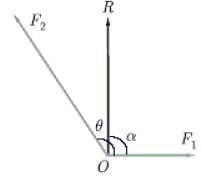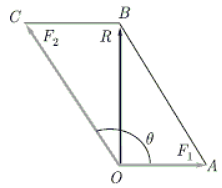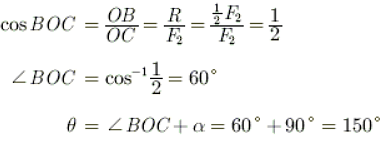Mechanical Engineering Exam > Mechanical Engineering Questions > The resultant of two forces acts along a lin...
Start Learning for Free
The resultant of two forces acts along a line perpendicular to one force and its magnitude is 1/2 of the other force. What will be the angle (θ) between the forces(in degrees)? (Answer up to the nearest integer)
Correct answer is '150'. Can you explain this answer?
| FREE This question is part of | Download PDF Attempt this Test |
Most Upvoted Answer
The resultant of two forces acts along a line perpendicular to one fo...
AS per the problem statement the forces will be as shown in figure. Here



F1 = ?
F2 = ?
R = F2/2
α = 90o
θ = ?
In right angle triangle OCB in figure.


Free Test
FREE
| Start Free Test |
Community Answer
The resultant of two forces acts along a line perpendicular to one fo...
The problem states that the resultant of two forces acts along a line perpendicular to one force and its magnitude is 1/2 of the other force. We are asked to find the angle (θ) between the forces.
Let's break down the problem into smaller steps to solve it:
1. Understanding the problem:
- We have two forces acting on a point.
- The resultant force acts along a line perpendicular to one of the forces.
- The magnitude of the resultant force is 1/2 of the magnitude of the other force.
- We need to find the angle between the two forces.
2. Representing the forces:
- Let's assume the magnitude of one force as F.
- The magnitude of the other force will be 2F (as it's twice the magnitude of the resultant force).
- We can represent the forces using vectors: F and 2F.
3. Drawing a diagram:
- Draw a coordinate system.
- Represent the forces F and 2F as vectors on the coordinate system.
- The resultant force R will be perpendicular to force F.
4. Finding the components of the forces:
- Break down the forces F and 2F into their x and y components.
- Since the resultant force R is perpendicular to F, its x-component will be zero.
- The y-component of R will be equal to the y-component of F, as there is no other force in the y-direction.
- The x-component of 2F will be zero, as it is perpendicular to R.
- The y-component of 2F will be equal to twice the y-component of R, as it is twice the magnitude of R.
5. Using trigonometry:
- We can find the angle θ using the components of the forces.
- The tan(θ) can be calculated as the ratio of the y-component of F to the x-component of 2F.
- tan(θ) = (y-component of F) / (x-component of 2F).
- Substitute the values and solve for θ.
- Take the inverse tangent of both sides to find θ.
6. Calculating the angle:
- Plug in the values into the equation and solve for θ.
- The calculated angle should be approximately 150 degrees.
Therefore, the angle (θ) between the forces is 150 degrees.
Let's break down the problem into smaller steps to solve it:
1. Understanding the problem:
- We have two forces acting on a point.
- The resultant force acts along a line perpendicular to one of the forces.
- The magnitude of the resultant force is 1/2 of the magnitude of the other force.
- We need to find the angle between the two forces.
2. Representing the forces:
- Let's assume the magnitude of one force as F.
- The magnitude of the other force will be 2F (as it's twice the magnitude of the resultant force).
- We can represent the forces using vectors: F and 2F.
3. Drawing a diagram:
- Draw a coordinate system.
- Represent the forces F and 2F as vectors on the coordinate system.
- The resultant force R will be perpendicular to force F.
4. Finding the components of the forces:
- Break down the forces F and 2F into their x and y components.
- Since the resultant force R is perpendicular to F, its x-component will be zero.
- The y-component of R will be equal to the y-component of F, as there is no other force in the y-direction.
- The x-component of 2F will be zero, as it is perpendicular to R.
- The y-component of 2F will be equal to twice the y-component of R, as it is twice the magnitude of R.
5. Using trigonometry:
- We can find the angle θ using the components of the forces.
- The tan(θ) can be calculated as the ratio of the y-component of F to the x-component of 2F.
- tan(θ) = (y-component of F) / (x-component of 2F).
- Substitute the values and solve for θ.
- Take the inverse tangent of both sides to find θ.
6. Calculating the angle:
- Plug in the values into the equation and solve for θ.
- The calculated angle should be approximately 150 degrees.
Therefore, the angle (θ) between the forces is 150 degrees.
Attention Mechanical Engineering Students!
To make sure you are not studying endlessly, EduRev has designed Mechanical Engineering study material, with Structured Courses, Videos, & Test Series. Plus get personalized analysis, doubt solving and improvement plans to achieve a great score in Mechanical Engineering.

|
Explore Courses for Mechanical Engineering exam
|

|
Similar Mechanical Engineering Doubts
The resultant of two forces acts along a line perpendicular to one force and its magnitude is 1/2 of the other force. What will be the angle (θ) between the forces(in degrees)? (Answer up to the nearest integer)Correct answer is '150'. Can you explain this answer?
Question Description
The resultant of two forces acts along a line perpendicular to one force and its magnitude is 1/2 of the other force. What will be the angle (θ) between the forces(in degrees)? (Answer up to the nearest integer)Correct answer is '150'. Can you explain this answer? for Mechanical Engineering 2024 is part of Mechanical Engineering preparation. The Question and answers have been prepared according to the Mechanical Engineering exam syllabus. Information about The resultant of two forces acts along a line perpendicular to one force and its magnitude is 1/2 of the other force. What will be the angle (θ) between the forces(in degrees)? (Answer up to the nearest integer)Correct answer is '150'. Can you explain this answer? covers all topics & solutions for Mechanical Engineering 2024 Exam. Find important definitions, questions, meanings, examples, exercises and tests below for The resultant of two forces acts along a line perpendicular to one force and its magnitude is 1/2 of the other force. What will be the angle (θ) between the forces(in degrees)? (Answer up to the nearest integer)Correct answer is '150'. Can you explain this answer?.
The resultant of two forces acts along a line perpendicular to one force and its magnitude is 1/2 of the other force. What will be the angle (θ) between the forces(in degrees)? (Answer up to the nearest integer)Correct answer is '150'. Can you explain this answer? for Mechanical Engineering 2024 is part of Mechanical Engineering preparation. The Question and answers have been prepared according to the Mechanical Engineering exam syllabus. Information about The resultant of two forces acts along a line perpendicular to one force and its magnitude is 1/2 of the other force. What will be the angle (θ) between the forces(in degrees)? (Answer up to the nearest integer)Correct answer is '150'. Can you explain this answer? covers all topics & solutions for Mechanical Engineering 2024 Exam. Find important definitions, questions, meanings, examples, exercises and tests below for The resultant of two forces acts along a line perpendicular to one force and its magnitude is 1/2 of the other force. What will be the angle (θ) between the forces(in degrees)? (Answer up to the nearest integer)Correct answer is '150'. Can you explain this answer?.
Solutions for The resultant of two forces acts along a line perpendicular to one force and its magnitude is 1/2 of the other force. What will be the angle (θ) between the forces(in degrees)? (Answer up to the nearest integer)Correct answer is '150'. Can you explain this answer? in English & in Hindi are available as part of our courses for Mechanical Engineering.
Download more important topics, notes, lectures and mock test series for Mechanical Engineering Exam by signing up for free.
Here you can find the meaning of The resultant of two forces acts along a line perpendicular to one force and its magnitude is 1/2 of the other force. What will be the angle (θ) between the forces(in degrees)? (Answer up to the nearest integer)Correct answer is '150'. Can you explain this answer? defined & explained in the simplest way possible. Besides giving the explanation of
The resultant of two forces acts along a line perpendicular to one force and its magnitude is 1/2 of the other force. What will be the angle (θ) between the forces(in degrees)? (Answer up to the nearest integer)Correct answer is '150'. Can you explain this answer?, a detailed solution for The resultant of two forces acts along a line perpendicular to one force and its magnitude is 1/2 of the other force. What will be the angle (θ) between the forces(in degrees)? (Answer up to the nearest integer)Correct answer is '150'. Can you explain this answer? has been provided alongside types of The resultant of two forces acts along a line perpendicular to one force and its magnitude is 1/2 of the other force. What will be the angle (θ) between the forces(in degrees)? (Answer up to the nearest integer)Correct answer is '150'. Can you explain this answer? theory, EduRev gives you an
ample number of questions to practice The resultant of two forces acts along a line perpendicular to one force and its magnitude is 1/2 of the other force. What will be the angle (θ) between the forces(in degrees)? (Answer up to the nearest integer)Correct answer is '150'. Can you explain this answer? tests, examples and also practice Mechanical Engineering tests.

|
Explore Courses for Mechanical Engineering exam
|

|
Suggested Free Tests
Signup for Free!
Signup to see your scores go up within 7 days! Learn & Practice with 1000+ FREE Notes, Videos & Tests.
























